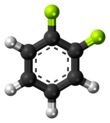1,2-Difluorobenzene
This colorless flammable liquid is a solvent used in the electrochemical studies of transition metal complexes.
Compared to most conventional halogenated aliphatic and aromatic solvents, it possesses an exceptionally high dielectric constant (ε0 = 13.8 at 300 K).
[2] Difluorobenzenes can be prepared by the Balz-Schiemann reaction, which entails conversion of diazonium tetrafluoroborate salts to their fluorides.
It is relatively chemically inert, weakly coordinating and has a relatively high dielectric constant.
In contrast to acetonitrile, DMSO, and DMF it is a weakly coordinating solvent for metal complexes, .

